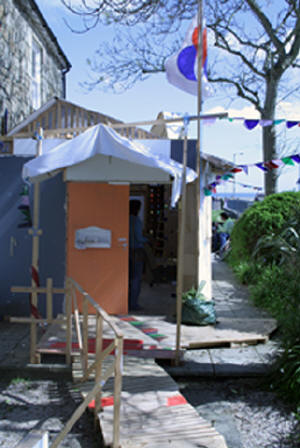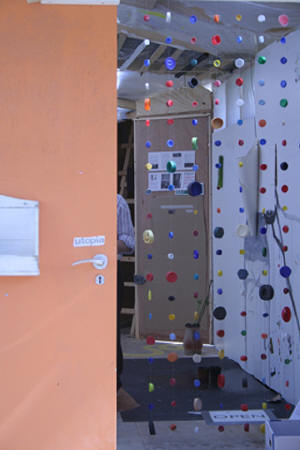| artcornwall | ||
| home | features | exhibitions | interviews | profiles | webprojects | gazetteer | links | archive | forum| | ||
| Reflections on Provisional Newlyn The original
Newlyn Gallery, home of the Newlyn Society of Artists, was opened in 1895. It
was commissioned by Passmore Edwards, who was responsible for the building of
the Whitechapel Picture Gallery. Its current period of renovation and partial
relocation meant that the gallery would have closed altogether had Dominic
Thomas not been asked to establish an alternative presence in the interim, a
place which would serve both as an information centre and be an artwork in its
own right.
The shed is a fitting location for a transitional art. It has connotations of retreat, of workshop for the mundane or spectacular, of makeshift den to house the imagination. It is democratic architecture in the sense that anyone with a modicum of DIY sense can build one. The haphazard construction that is Provisional Newlyn, complete with tower, veranda and insignias, declares its eccentricity and shows that you don’t have to stick to the rules on the IKEA flatpack box. Dominic Thomas and his assistant Jonty Lees see the building process itself as part of the project, and recall the construction with schoolboy enthusiasm. It is less self-conscious and certainly less rigidly organised than The Other Flower Show at the V&A, (2004) where a group of well-known artists were each asked to transform a garden shed. Provisional Newlyn owes more visually to the gaffer-taped cardboard constructions of Thomas Hirshhorn, and like his work, it sacrifices craftsmanship and quality in the interests of harnessing energy. Dominic Thomas’s work has moved into process-based areas where the location of the actual artwork is not easy to define. Like his mobile project Mundusloci, where he and his family took a VW van around Europe, Provisional Newlyn has been diarised with photos and film. Three leaflets have been produced over the course of the month in an attempt to crystallise conceptually and philosophically some of the themes that have arisen from the project. In PN # two Martin Wooster states “A community gives us the potential to both affirm our legitimate differences from each other and to explore all our diverse dimensions, but this is only possible if something of this constituted space in part remains indeterminate, escapes all calculation.” Does the equivocal nature of Provisional Newlyn allow for such explorations? Certainly in the organic way a programme of events developed, not only through the response of invited artists, but also, refreshingly, by people requesting a slot after visiting or hearing about the project. Indeed the atmosphere and function of the shed has been transformed according to the style in which it has been temporarily inhabited by different personalities over the month. Alexis Stevens
and Charles Napier used the opportunity for an experiment in collaborative
three-dimensional “drawing” employing found materials in a game of visual
consequences. Lilly Keal and William Ainley from Bristol responded to the garden
shed connotations and transformed the space with theatrical flair in a
fantastical recreation of an actual location. There was a visit from
Lucy Willow
and Marion Taylor in their ‘In-Transit’ mobile art van, and talks on the
philosophy behind recycled bikes by a local blacksmith, Dave Tigwell. Other pieces relied heavily on interaction with visitors. Mary Fletcher drew portraits as the sitters described an event they had just missed and Jane Bailey used the space as “an incubator to hothouse ideas” for a session of Latin Plant Verse. Oliver Sutherland created an imaginary tube station by painting the yellow line of a platform edge across the floor and playing sounds recorded on London Underground - the audience becoming willing participants in this illusion, Coinciding with the Easter holiday pilgrimage to the Cornish coast, there was a steady stream of visitors and their children. It appeared that some would rather gnaw off their leg than engage with an art event. Looking scared at the obvious absence of Newlyn School painters, they were cordially dispatched to nearby Penlee House where the actual collection is housed. Others were fascinated or simply took advantage of the distraction offered by the informal kids workshops that developed daily. The democratic nature of the project and the lack of a clear agenda on the part of the “facilitators” meant all interested parties had to receive an equal welcome and introduction to whatever was going on. Because the project had no specific boundaries, the nature of the audience was also unspecific - nothing could be assumed about them and this could not be controlled. Kids from the local park infiltrated the space and had drawings of their own dens displayed on the walls, and the last time I visited a man wheeling a dog around in a wooden trolley was asking when his digital prints would be exhibited. The transience of the environment encouraged a rapid, open-ended evolution of ideas to develop and interestingly, this use of the space as a site for experimentation ties in with Thomas’s preoccupation with the themes of chance and failure. By creating something without preconceived ideas about outcome, in a space that is neither private studio nor public gallery, how do you define your activity, let alone measure the success or failure of your endeavour? For all those who took part there was the challenge of working in a public place, sometimes having to provide a commentary for an indefinite process. Alexis Stevens said she felt like a piece of art herself but enjoyed the opportunity to take risks in public without the pressure of an agreed brief or even guidelines. Amanda Lorens revelled in the performative opportunity offered by the space and physically adapted it to suit her needs. She shut her audience out and made voyeurs of the spectators, letting them spy on her and her partner as they danced a forty-five minute tango. This unfolded metaphors around the shed as a sanctuary at the bottom of the garden – a site for seedy intimacies or obsessive tendencies had been re-imagined as a private world where the everyday becomes fabulous. There is something quite humbling about the whole venture in the sense that artists were laying bare the process that is an essential part of their practice in an atmosphere that was without hierarchy or pretension. It provided an uncensored forum for dialogue. Makeshift and awkward, far from perfect, Provisional Newlyn was a very human endeavour. Provisional Newlyn ran from 8th April to 6th May 2006 Text Megan Wakefield Pictures Miranda May July 2006
|

